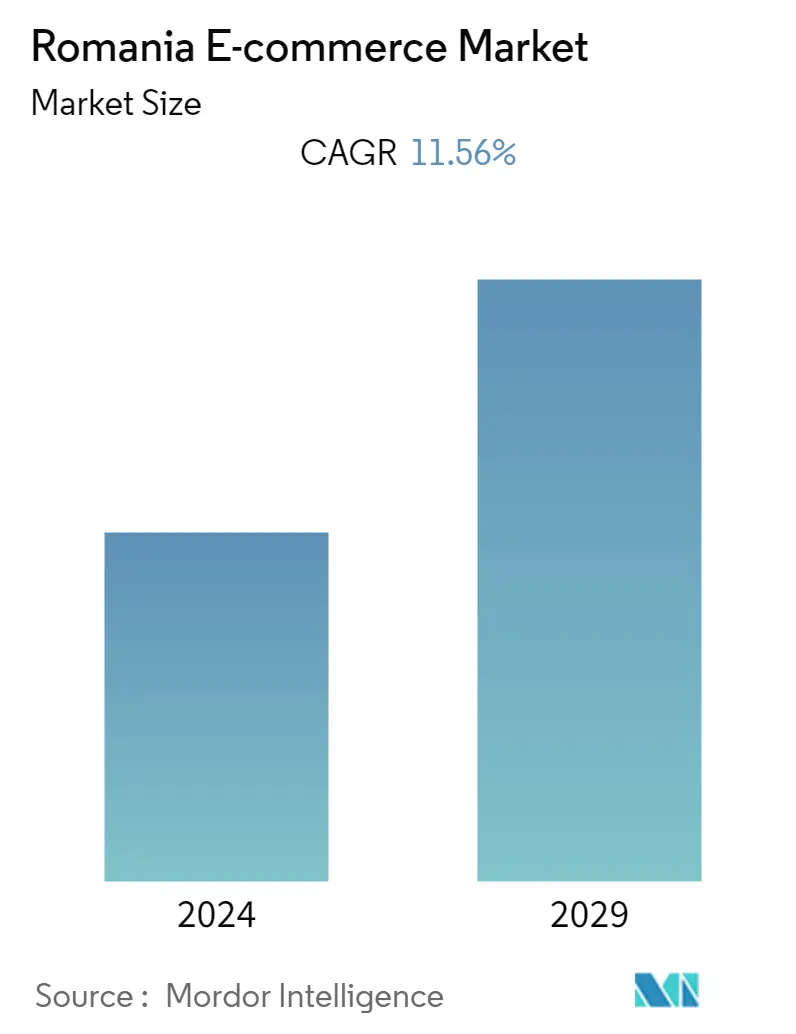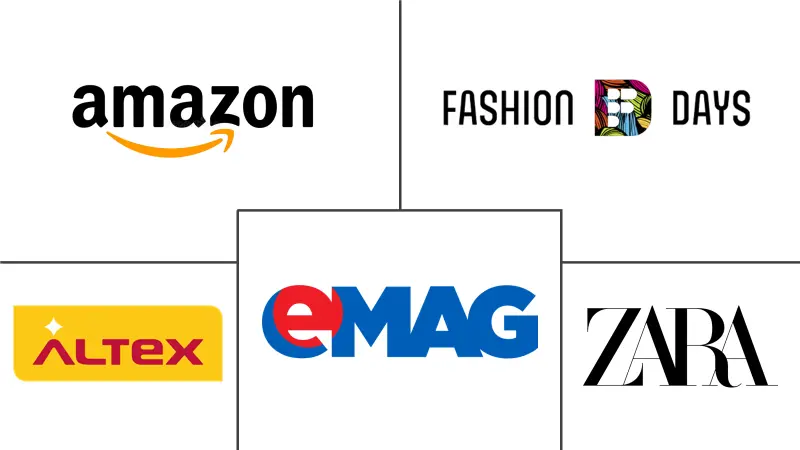Market Size of Romania E-commerce Industry

| Study Period | 2019 - 2029 |
| Base Year For Estimation | 2023 |
| Forecast Data Period | 2024 - 2029 |
| Historical Data Period | 2019 - 2022 |
| CAGR | 11.56 % |
| Market Concentration | Low |
Major Players
*Disclaimer: Major Players sorted in no particular order |
Romania E-commerce Market Analysis
The Romanian e-commerce market is expected to register a CAGR of 11.56% during 2022-2027. The Romanian e-commerce market is primarily driven by the increasing internet penetration, advanced infrastructure, and an increased number of online shoppers.
- E-commerce is witnessing rapid growth in the Romanian market. The factors like internet penetration, the rise in the tech-savvy youth population, and other factors are driving Romania's e-commerce market.
- The local market in Romania has around 100 online stores registering over 1,000 orders per day. Still, it is expected to increase to triple times in the coming three years, based on various digital transformation trends that will define local e-commerce.
- According to International Trade Administration, in 2021, working remotely and virtual schooling will increase the usage of online communication solutions. As a result, internet service penetration increased, resulting in a 33 percent rise in traffic from connected desktops and a 12 percent increase in traffic from mobile devices.
- Various companies are coming up with their e-commerce platform in the region due to the e-commerce market's significant growth. For instance, in February 2022, Macromex, Grocery, and Related Product Merchant Wholesalers Industry announced the launch of the Bocado. ro platform, the e-commerce solution.
- The food e-commerce market is recording growth and opportunity in the Romania market. Many partnerships are taking place by various e-commerce market players to boost the market further. For instance, in January 2022, Golden Foods Snacks SA announced its partnership with PepsiCo to distribute its products in Romania.
Romania E-commerce Industry Segmentation
Conducting an e-commerce business means fostering relationships and selling information, services, and goods over computer communication networks. E-commerce usually refers to trading goods and services over the internet, which means broader economic activity. E-commerce consists of B2B and B2C and internal organizational transactions that support these activities.
The study also tracks the key market parameters, underlying growth influencers, and major vendors operating in the industry, which supports the market estimations and growth rates over the forecast period in Romania. The study further analyzes the overall impact of COVID-19 on the ecosystem. The scope of the report encompasses market sizing and forecast for segmentation by B2B and B2C, in which the B2C channel is further segmented by application.
| By B2C ecommerce | ||||||||
| Market size (GMV) for the period of 2017-2027 | ||||||||
|
| By B2B ecommerce | |
| Market size for the period of 2017-2027 |
Romania E-commerce Market Size Summary
The Romanian e-commerce market is experiencing robust growth, driven by factors such as increased internet penetration, advanced infrastructure, and a growing number of tech-savvy online shoppers. The market is characterized by a significant rise in digital transformation trends, which are expected to triple the number of online stores and orders in the coming years. The COVID-19 pandemic has further accelerated this growth, as more Romanians turned to digital shopping and e-payments, expanding the customer base for online businesses. The market is also witnessing the emergence of new e-commerce platforms and partnerships, particularly in the food sector, as companies seek to capitalize on the growing demand for online retailing.
The digital economy in Romania is evolving, supported by government initiatives and strategic partnerships aimed at enhancing the country's digital infrastructure. The introduction of digital solutions such as electronic identity cards and government cloud services is expected to bolster the e-commerce sector. Additionally, the fashion industry is seeing continuous growth, with major players expanding their presence through acquisitions and new store openings. Social media's role in e-commerce is also increasing, with platforms developing their own e-commerce sites to tap into the growing user base. The competitive landscape is marked by the presence of major players like Altex and Everli, who are expanding their operations and offering innovative solutions to meet the rising demand in the Romanian e-commerce market.
Romania E-commerce Market Size - Table of Contents
-
1. MARKET INSIGHTS
-
1.1 Market Overview
-
1.2 Industry Attractiveness-Porter's Five Force Analysis
-
1.2.1 Bargaining Power of Suppliers
-
1.2.2 Bargaining Power of Buyers/Consumers
-
1.2.3 Threat of New Entrants
-
1.2.4 Threat of Substitute Products
-
1.2.5 Intensity of Competitive Rivalry
-
-
1.3 Key market trends and share of e-commerce of total Retail sector
-
1.4 Impact of COVID-19 on the e-commerce sales
-
-
2. Market Segmentation
-
2.1 By B2C ecommerce
-
2.1.1 Market size (GMV) for the period of 2017-2027
-
2.1.2 Market Segmentation - by Application
-
2.1.2.1 Beauty and Personal Care
-
2.1.2.2 Consumer Electronics
-
2.1.2.3 Fashion and Apparel
-
2.1.2.4 Food and Beverage
-
2.1.2.5 Furniture and Home
-
2.1.2.6 Others (Toys, DIY, Media, etc.)
-
-
-
2.2 By B2B ecommerce
-
2.2.1 Market size for the period of 2017-2027
-
-
Romania E-commerce Market Size FAQs
What is the current Romania E-commerce Market size?
The Romania E-commerce Market is projected to register a CAGR of 11.56% during the forecast period (2024-2029)
Who are the key players in Romania E-commerce Market?
Amazon.com, Inc., Fashion Days Shopping SRL., Altex Romania SRL, Zara USA, Inc and emag.ro (Dante International S.A ) are the major companies operating in the Romania E-commerce Market.

